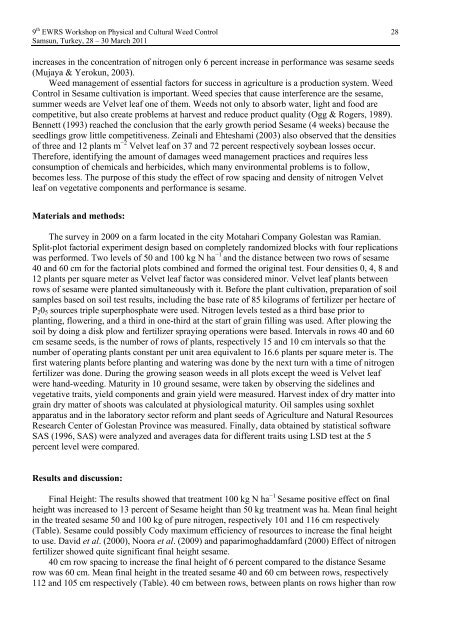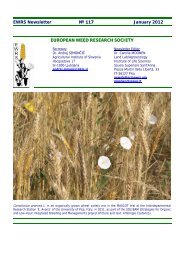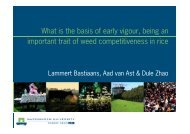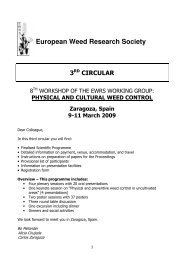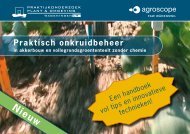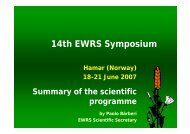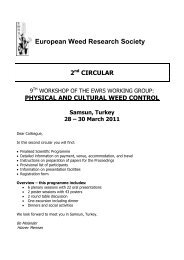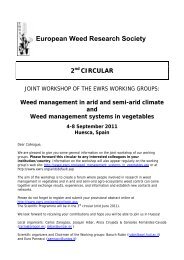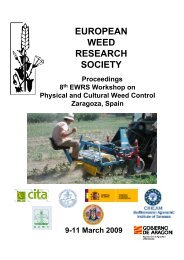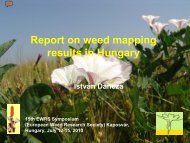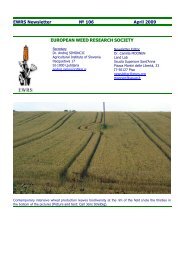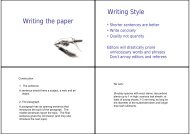Physical and Cultural Weed Control Working Group of - European ...
Physical and Cultural Weed Control Working Group of - European ...
Physical and Cultural Weed Control Working Group of - European ...
You also want an ePaper? Increase the reach of your titles
YUMPU automatically turns print PDFs into web optimized ePapers that Google loves.
9 th EWRS Workshop on <strong>Physical</strong> <strong>and</strong> <strong>Cultural</strong> <strong>Weed</strong> <strong>Control</strong> 28<br />
Samsun, Turkey, 28 – 30 March 2011<br />
increases in the concentration <strong>of</strong> nitrogen only 6 percent increase in performance was sesame seeds<br />
(Mujaya & Yerokun, 2003).<br />
<strong>Weed</strong> management <strong>of</strong> essential factors for success in agriculture is a production system. <strong>Weed</strong><br />
<strong>Control</strong> in Sesame cultivation is important. <strong>Weed</strong> species that cause interference are the sesame,<br />
summer weeds are Velvet leaf one <strong>of</strong> them. <strong>Weed</strong>s not only to absorb water, light <strong>and</strong> food are<br />
competitive, but also create problems at harvest <strong>and</strong> reduce product quality (Ogg & Rogers, 1989).<br />
Bennett (1993) reached the conclusion that the early growth period Sesame (4 weeks) because the<br />
seedlings grow little competitiveness. Zeinali <strong>and</strong> Ehteshami (2003) also observed that the densities<br />
<strong>of</strong> three <strong>and</strong> 12 plants m −2 Velvet leaf on 37 <strong>and</strong> 72 percent respectively soybean losses occur.<br />
Therefore, identifying the amount <strong>of</strong> damages weed management practices <strong>and</strong> requires less<br />
consumption <strong>of</strong> chemicals <strong>and</strong> herbicides, which many environmental problems is to follow,<br />
becomes less. The purpose <strong>of</strong> this study the effect <strong>of</strong> row spacing <strong>and</strong> density <strong>of</strong> nitrogen Velvet<br />
leaf on vegetative components <strong>and</strong> performance is sesame.<br />
Materials <strong>and</strong> methods:<br />
The survey in 2009 on a farm located in the city Motahari Company Golestan was Ramian.<br />
Split-plot factorial experiment design based on completely r<strong>and</strong>omized blocks with four replications<br />
was performed. Two levels <strong>of</strong> 50 <strong>and</strong> 100 kg N ha −1 <strong>and</strong> the distance between two rows <strong>of</strong> sesame<br />
40 <strong>and</strong> 60 cm for the factorial plots combined <strong>and</strong> formed the original test. Four densities 0, 4, 8 <strong>and</strong><br />
12 plants per square meter as Velvet leaf factor was considered minor. Velvet leaf plants between<br />
rows <strong>of</strong> sesame were planted simultaneously with it. Before the plant cultivation, preparation <strong>of</strong> soil<br />
samples based on soil test results, including the base rate <strong>of</strong> 85 kilograms <strong>of</strong> fertilizer per hectare <strong>of</strong><br />
P205 sources triple superphosphate were used. Nitrogen levels tested as a third base prior to<br />
planting, flowering, <strong>and</strong> a third in one-third at the start <strong>of</strong> grain filling was used. After plowing the<br />
soil by doing a disk plow <strong>and</strong> fertilizer spraying operations were based. Intervals in rows 40 <strong>and</strong> 60<br />
cm sesame seeds, is the number <strong>of</strong> rows <strong>of</strong> plants, respectively 15 <strong>and</strong> 10 cm intervals so that the<br />
number <strong>of</strong> operating plants constant per unit area equivalent to 16.6 plants per square meter is. The<br />
first watering plants before planting <strong>and</strong> watering was done by the next turn with a time <strong>of</strong> nitrogen<br />
fertilizer was done. During the growing season weeds in all plots except the weed is Velvet leaf<br />
were h<strong>and</strong>-weeding. Maturity in 10 ground sesame, were taken by observing the sidelines <strong>and</strong><br />
vegetative traits, yield components <strong>and</strong> grain yield were measured. Harvest index <strong>of</strong> dry matter into<br />
grain dry matter <strong>of</strong> shoots was calculated at physiological maturity. Oil samples using soxhlet<br />
apparatus <strong>and</strong> in the laboratory sector reform <strong>and</strong> plant seeds <strong>of</strong> Agriculture <strong>and</strong> Natural Resources<br />
Research Center <strong>of</strong> Golestan Province was measured. Finally, data obtained by statistical s<strong>of</strong>tware<br />
SAS (1996, SAS) were analyzed <strong>and</strong> averages data for different traits using LSD test at the 5<br />
percent level were compared.<br />
Results <strong>and</strong> discussion:<br />
Final Height: The results showed that treatment 100 kg N ha −1 Sesame positive effect on final<br />
height was increased to 13 percent <strong>of</strong> Sesame height than 50 kg treatment was ha. Mean final height<br />
in the treated sesame 50 <strong>and</strong> 100 kg <strong>of</strong> pure nitrogen, respectively 101 <strong>and</strong> 116 cm respectively<br />
(Table). Sesame could possibly Cody maximum efficiency <strong>of</strong> resources to increase the final height<br />
to use. David et al. (2000), Noora et al. (2009) <strong>and</strong> paparimoghaddamfard (2000) Effect <strong>of</strong> nitrogen<br />
fertilizer showed quite significant final height sesame.<br />
40 cm row spacing to increase the final height <strong>of</strong> 6 percent compared to the distance Sesame<br />
row was 60 cm. Mean final height in the treated sesame 40 <strong>and</strong> 60 cm between rows, respectively<br />
112 <strong>and</strong> 105 cm respectively (Table). 40 cm between rows, between plants on rows higher than row


